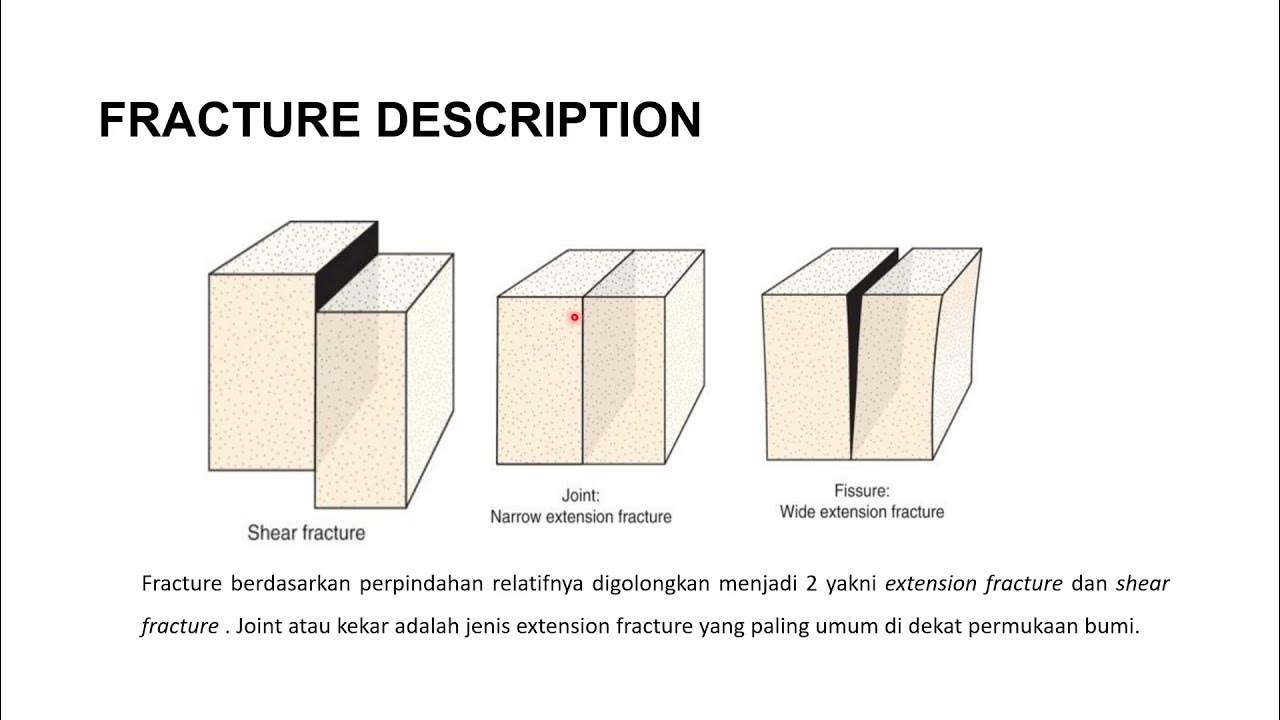Geologi Struktur - Joint dan Vein - 4. Type of Vein
Summary
TLDRIn this video, the focus is on veins and fractures in geology, particularly those formed due to deformation. The lesson explores the types of veins, such as fibrous (syntaxial and antisyntaxial), their formation, and their importance in measuring geological stress and strain. The video emphasizes the economic value of veins, their role in mineral deposits, and their significance in tectonic studies. It also highlights the impact of repeated deformation on veins, aiding in the understanding of regional tectonic histories. Finally, the study of veins is crucial for various applications in geotechnical engineering, oil exploration, and groundwater management.
Takeaways
- 😀 Veins (also called 'paint') are fractures in rocks filled with minerals, formed due to various geological processes.
- 😀 Fractures and veins are important for studying both local and regional deformation in geological formations.
- 😀 Fractures are useful for measuring strain, volume change, temperature, and pressure conditions during their formation.
- 😀 The minerals found in veins can help determine their age and the temperature and pressure conditions during their formation.
- 😀 Veins can have significant economic value, as many mineral deposits are found within them.
- 😀 Fibrous minerals in veins (known as 'brush') are oriented in the direction of stretching, which provides insights into tectonic forces.
- 😀 Two types of veins exist: **syntactic veins**, which have the same composition as the surrounding rock, and **anti-syntactic veins**, which differ from the surrounding rock composition.
- 😀 Syntactic veins develop by adding minerals from the edges inward, while anti-syntactic veins add minerals from the edges outward.
- 😀 Fractures can undergo repeated deformation, filling with minerals in multiple stages, offering insights into tectonic history and stress patterns.
- 😀 Fractures and veins can be used to study fluid movement in the Earth’s crust, playing a role in resource extraction and groundwater studies.
Q & A
What is the focus of this video transcript?
-The video discusses the topic of fractures (also called 'fans') in geological contexts, specifically covering the types of fractures, their formation, and their importance in geological studies, such as deformation, mineral content, and their economic value.
What is a 'fan' in geology?
-A fan in geology refers to a fracture or crack in rocks that is filled with minerals. These fractures can form through tectonic processes and are important for understanding geological deformations.
How do fractures help in understanding geological deformation?
-Fractures help in understanding deformation by providing evidence of strain and stress in the rock. By studying the minerals in fractures, geologists can determine the temperature and pressure conditions at the time of their formation.
What are the two types of fibrous fractures discussed in the video?
-The two types of fibrous fractures discussed are syntaxial and antitaxial fractures. Syntaxial fractures have mineral compositions similar to the surrounding rock, while antitaxial fractures have a different composition.
What distinguishes syntaxial fractures from antitaxial fractures?
-Syntaxial fractures are characterized by having the same mineral composition as the surrounding rock, with mineral growth starting from the edges and progressing towards the center. In contrast, antitaxial fractures develop with a different composition from the surrounding rock, with mineral growth starting from the edges and progressing outward.
What is the role of fibrous minerals in fractures?
-Fibrous minerals, such as those growing along the walls of fractures, help to indicate the direction of strain and the extent of deformation. These minerals can align with the main axis of extension, providing important clues about the history of deformation.
How do fractures contribute to economic geology?
-Fractures can be valuable in economic geology as they often contain mineral deposits that can be economically extracted. Fractures also enhance permeability and porosity in rocks, making them potential reservoirs for oil, gas, or groundwater.
What are the possible consequences of fractures in geological structures?
-Fractures can increase the risk of rock weathering and degradation, which could impact construction projects. They also make the rock more susceptible to fluid migration, potentially leading to oil or gas reservoirs, but could also pose challenges for infrastructure stability.
What is the importance of measuring fractures in geological studies?
-Measuring fractures, including their orientation, density, and spacing, is crucial for understanding the tectonic history of an area. This data can be used for applications in engineering, petroleum exploration, and water management.
Why should construction projects avoid zones with complex fractures?
-Construction projects should avoid areas with complex fracture zones because these regions are prone to further deformation, which could lead to structural instability. The fractures in these areas can activate over time, potentially causing damage to buildings or infrastructure.
Outlines

Esta sección está disponible solo para usuarios con suscripción. Por favor, mejora tu plan para acceder a esta parte.
Mejorar ahoraMindmap

Esta sección está disponible solo para usuarios con suscripción. Por favor, mejora tu plan para acceder a esta parte.
Mejorar ahoraKeywords

Esta sección está disponible solo para usuarios con suscripción. Por favor, mejora tu plan para acceder a esta parte.
Mejorar ahoraHighlights

Esta sección está disponible solo para usuarios con suscripción. Por favor, mejora tu plan para acceder a esta parte.
Mejorar ahoraTranscripts

Esta sección está disponible solo para usuarios con suscripción. Por favor, mejora tu plan para acceder a esta parte.
Mejorar ahoraVer Más Videos Relacionados
5.0 / 5 (0 votes)






